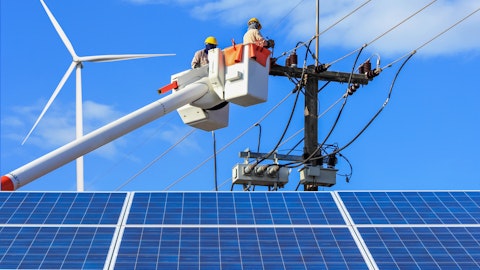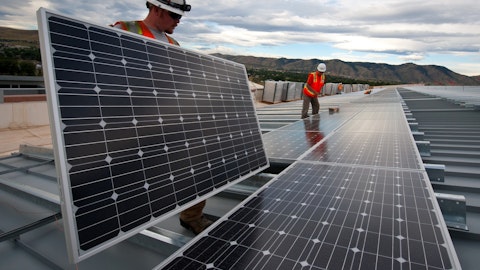Array Technologies, Inc. (NASDAQ:ARRY) Q4 2022 Earnings Call Transcript March 21, 2023
Operator: Hello and welcome to the Array Technologies’ Fourth Quarter and Full Year 2022 Earnings Call. At this time, all participants are in a listen-only mode. A question-and-answer session will follow the formal presentation. As a reminder, this conference is being recorded. It’s now my pleasure to turn the call over to Cody Mueller, Investor Relations at Array Technologies. Please go ahead.
Cody Mueller: Good evening and thank you for joining us on today’s conference call to discuss Array Technologies’ fourth quarter and full year 2022 results. Slides for today’s presentation are available on the Investor Relations section of our website, arraytecinc.com. During this conference call, management will make forward-looking statements based on our current expectations and assumptions, which are subject to risks and uncertainties. Actual results could differ materially from our forward-looking statements if any of our key assumptions are incorrect. We identify the principal risks and uncertainties that may affect our performance in our reports and filings with the Securities and Exchange Commission, which can also be found on our Investor Relations website.
We do not undertake a duty to update any forward-looking statements. Today’s presentation also includes references to non-GAAP financial measures. You should refer to the information contained in the company’s fourth quarter press release for definitional information and reconciliations of historical non-GAAP measures to the comparable GAAP financial measures. With that, let me turn the call over to Kevin Hostetler, Array Technologies’ Chief Executive Officer.
Kevin Hostetler: Thanks Cody and welcome everyone. In addition to Cody, I’m also joined by Nipul Patel, our Chief Financial Officer; and Erica Brinker, our Chief Commercial Officer. Let’s begin on slide four, where I will provide some highlights of our fourth quarter and full year results. We closed out 2022 with continued strong performance as revenue, adjusted EBITDA, and adjusted EPS were all above the midpoint of our previously issued full year guidance. Despite the continued module availability challenges and a number of site closures due to weather late in the year, we were still able to deliver revenue in the quarter of $402 million. This represents an increase of 83% from prior year’s fourth quarter of which 22% was organic growth within our legacy Array segment.
This puts our full year revenue at $1.638 billion, which exceeds the high end of our guidance range for the year and represents organic growth of nearly 50% and total growth of 92% from 2021. It is important to take a minute and put that growth in context. 2022 was a year marked with consistent module availability challenges; from WRO in the beginning of the year, to ADC BD in the spring and summer, and finally, the UFLPA in the second half of the year. The design of our Tracker system where we do not require pre-drilling into the torque tube, allowed our customers to make more flexible approach to the design of their sites in close conjunction with our applications engineering team. In instances where module availability was unknown during the design process, Array was able to support customers by designing a site with multiple module options.
This ensured that as soon as modules became available, the time to install was greatly reduced. This is a testament to not only the unique design of our products, but also to our in-house engineering expertise. As I move down to gross margin, I’m happy to report that for the fourth quarter, our total company gross margin was 20%, which represents over a 1,500 basis point increase from the fourth quarter of last year and is well within the high teens to low 20s benchmark we established as an exit point for 2022. This brings full year gross margins to 13.9%, which is a 420 basis point increase from the prior year gross margin of 9.7%. Almost two years ago when our company felt the impact of the rapid rise in commodity prices, we moved quickly to change the way that our business operates to minimize the potential future impact of rapidly escalating commodities.
We also outlined our path to get back to our historical gross margin profile. This quarter marks an important closeout to that journey as we are finally back into the range that we would expect as a baseline gross margin for the business. As we move into 2023 and beyond, I’ll be happy to no longer address the impacts of those legacy priced contracts to our gross margin. On the back of the volume growth and improved profitability, adjusted EBITDA for the quarter grew to $52 million, up from $0.5 million in the prior year. And for the full year, grew to $129 million, up from $43 million in 2021. This means our adjusted EBITDA in the fourth quarter of this year was higher than the full year in 2021. This is an indication of just how far our company has come in a short period of time.
Finally, we delivered $131 million of free cash flow in 2022, anchored by $86 million in the fourth quarter alone. The results here are indicative of our intense focus on both improving our profitability and our working capital efficiency. As we wrap-up 2022 and move into 2023, we do so with a lot of momentum. Our growth is undeniable. We have the largest market share in the US, which will have significant volume gains in the coming years, our margins are the best in the industry and we have solidified our balance sheet and liquidity to position us for future growth. Now, let’s move to slide five to talk a little bit more about future growth and the state of the industry both here in the US and in the rest of the world. Starting first, the more near-term outlook here in the US.
Our volume outlook for 2023 still supports a healthy level of growth despite ongoing uncertainty in a couple of areas. First, the UFLPA has shown some recent positive signs of improvement, but the fact remains that module availability is still a concern to customers until we get to a more final resolution. We will continue to approach forecasting the impact to us in a similar fashion as before, assuming a slightly slower conversion of projects as we work to offer flexible solutions to our customers. And second, the timing of demand acceleration from the implementation of the IRA domestic content provision. Projects are still moving forward and what we would say is a status quo manner. Meaning, we have not yet seen an acceleration of new projects, but are still seeing a steady level of order activity as demonstrated by the roughly $500 million in orders received in Q4.
While there are some other dynamics at play here like permitting, labor availability, et cetera, the main feedback we get is that there needs to be clarification from the Department of Treasury on what qualifies as domestic content under the IRA. For developers that have some flexibility in their project timing, it is worth waiting to ensure they maximize the return from this provision. Once we do have resolution in this provision, we would expect to see order activity increase. On the manufacturing credit side, we remain consistent with our belief that there is a roughly 15% of the overall tracker price worth of value in these credits. This estimate does not include our clamping solution, which is included in the final guidelines, would be an incremental benefit.
However, we still do not know the timing of when the credits can be applied for and what the ultimate transferability will be. Because these credits are retroactive applicable to January 1st of this year, we certainly expect some benefit from these credits, but we can’t yet estimate what the value will be or where it will show up in our financial statement. Due to the uncertainty in these two areas, we have made the determination not to include any potential direct benefits from the IRA to our profitability in our 2023 guidance range. When we do receive more clarification, we will provide as much transparency as we can into the financial impact to Array. As we look past 2023, there are a couple of observations that I believe are important to point out.
As has been true for a while now, the long-term demand health in the industry remains incredibly strong. We expect that solar energy will become a 50-state solution and that it will lead to an increase in the geographic diversity of the sites that will be built. This means more challenging terrain and weather conditions will become the norm, not the exception. For tracker companies, it will be increasingly important to offer a diverse set of products in order to maximize the site’s energy output. In the next slide, I will outline how exactly we are going to do that at Array. Finally, with the level of transparency and sharing of benefits that will occur in the industry due to the IRA, it will be difficult for industry participants to maximize their returns with transactional relationships, long-term partnerships across the supply chain will be key, and we are confident that the strategic relationships we have built over years and years will enable us to maximize our benefits under this bill.
If we shift towards our non-US business, there is also a lot to be excited about. In Brazil, we expect to see a strong 2023 as many large utility scale projects move forward post-election. This will augment our already strong distributed portfolio in that region to help deliver healthy growth. Another bright spot for us is in Australia. We just announced our VRET2 win on the Glenrowan project, which was predicated on being able to provide locally-sourced products. It is important to note that we were the first tracker company to establish this local content footprint, which we expect will allow us to take advantage of the growth in this region over the coming years. Western Europe continues to see steady installations, but we have yet to see a true catalyst for growth like the IRA here in the US.

Pixabay/Public Domain
With the energy dynamics in the region, it is hard to imagine that accelerating growth in the utility scale solar is not coming. But until it does, we expect relatively tempered growth in the near-term. And finally, we are constantly evaluating new geographies. But we will continue to do so in a methodical and disciplined way ensuring that any market we get into is one where we have a strong value proposition and that we can maintain the strength of our margin profile. Being successful in this expansion both in the US and outside of it will be highly dependent on products and services we can offer to our customers. If we turn to slide six, I’d like to provide some additional color into our portfolio of offerings. With our announcement late last year, two additional product offerings, OmniTrack and the H250’s availability for the US market.
We offer our customer a broad set of trackers. With our flagship DuraTrack product, we are still the only tracker provider who can offer up to 32 linked rows, thanks to our patented drive line. This remains a key competitive differentiator as it allows for far fewer parts than other independent row systems, which means lower operating costs over the life of the project. Based on the DuraTrack architecture, we also launched our terrain following tracker, OmniTrack late last year. We are currently quoting for deliveries late in 2023. OmniTrack allows for up to 1% north south slope change in the torque tube, which is best in the industry. What that means practically is that we can greatly minimize or even eliminate the need to do site preparation work.
This benefit is becoming increasingly important to our customers as sites move to regions of the US, where flat land is not commonplace. As an added benefit, it also reduces permitting costs and is more environmentally-friendly as the natural landscape does not have to be disrupted. And finally, with the introduction of the H250 into the US market, we now offer a tracker which can be optimized for smaller or more irregular shapes, where a customer may not get the full benefit of DuraTrack’s linked row architecture. This allows us to target projects that may not have previously fit our criteria for profitability effectively increasing our available market here in the US, while still being able to maintain our target gross margin. Cutting across the Tracker portfolio is our SmarTrack software suite.
We have already deployed our backtracking and diffuse like versions of this software to multiple gigawatts of projects. But as we move into 2023, I’m happy to announce that we will expand the capabilities of this software to provide even further benefit to our customers. Here in the next few months, we will introduce SmarTrack’s weather response. This upgrade will allow the tracker to connect directly to a local weather provider in order to anticipate and adjust to upcoming severe weather events, namely hail and snow. For Hail stow, it will put the tracker in the best defensive position to minimize any damage to the modules. For Snow stow, it will put the modules at a maximum tilt to minimize the amount of snow load that accumulates on the tracker at any given time.
This will allow a site to be designed with fewer foundations and lowers the strength required in a module mounting interface. These updates further strengthen our software offering and our value proposition to our customers. With that, I will turn the call over to Nipul.
Nipul Patel: Thanks Kevin. Please turn to slide eight. Revenues for the fourth quarter increased 83$ to $402.1 million compared to $219.9 million for the prior year period, driven by higher ASP on our DuraTrack product and the acquisition of STI. The $402 million in revenue reflects $269 million from the legacy Array segment and $133 million from the FTI segment. Gross profit increased to $80.5 million from $10.3 million in the prior year period, driven primarily by an increase in volume from the acquisition of STI as well as ASP growth in our legacy Array segment. Gross margin increased to 20% from 4.7% as the legacy Array segment had minimal impact from our legacy price contracts in addition to strong margin performance in our FTI segment.
Gross margin for the legacy Array business was 18.2% and the FTI business had gross margin of 23.8% in the quarter. Operating expenses increased to $64.2 million compared to $30.3 million during the same period in the prior year. The higher expense is primarily related to a $24.7 million increase in amortization expense related to the STI acquisition. The remaining increase represents the additional operating expenses from the FTI business as well as higher headcount related costs to support the company’s growth and innovation. Net loss attributable to common shareholders was $17.3 million compared to a net loss of $32.1 million during the same period in the prior year and basic and diluted loss per share was $0.11 compared to basic and diluted loss per share of $0.24 during the same period in the prior year.
Adjusted EBITDA increased to $51.7 million compared to $453,000 for the prior year period. Adjusted net income increased to $15 million compared to adjusted net loss of $7.8 million during the same period in the prior year and adjusted basic and diluted net income per share was $0.10 compared to adjusted diluted net loss per share of $0.06 during the same period in the prior year. Finally, our free cash flow for the period was $85.7 million versus a use of cash of $98.5 million for the same period in the prior year. Now, turning to our full year results on slide nine. Revenue for the year increased 92% to $16.4 billion compared to $853.3 million for the prior year, driven by an organic increase of $414.6 million or 49%, attributable to both an increase in the total number of megawatts shipped and an increase in ASP.
Revenue growth was also driven by the acquisition of STI Norland, which contributed revenue of $369.7 million. In 2021, we shipped 9.6 gigawatts at an average selling price of $0.088 per watt. In 2022, we shipped 14.4 gigawatts at an average selling price of $0.113 per watt. Gross profit increased to $227.3 million from $82.9 million in the prior, year driven by the increase in volume both from the acquisition of STI as well as our organic growth. Gross margin increased to 13.9% from 9.7%, driven by a larger portion of higher-priced contracts and the addition of STI. Operating expenses increased to $245.4 million compared to $107.6 million in the prior year. The higher expenses primarily related to a $74.7 million increase in amortization expense related to the STI acquisition.
The remaining increase represents the additional operating expenses from the FTI business as well as higher headcount related costs to support the company’s growth and innovation as well as higher professional fees related to the acquisition of STI and increase in legal and audit fees. Net loss attributable to common shareholders was $43.6 million compared to net loss of $66.1 million during the prior year and basic and diluted loss per share was $0.29 compared to basic and diluted loss per share of $0.51 during the same period in the prior year. Adjusted EBITDA increased to $128.7 million compared to $43.2 million for the prior year due to higher gross margins. Adjusted net income increased to $57.3 million compared to $8.7 million during the prior year and adjusted basic and diluted net income per share was $0.38 compared to income per share of $0.07 during the same period in the prior year.
Finally, our free cash flow for the year was $131 million versus negative $267 million for the prior year. The increase was driven by both improved profitability, but also an improvement in our cash conversion cycle of 35 days, from 110 days in the fourth quarter of 2021 to 75 days in the fourth quarter of this year. Now, I’d like to go to slide 10, where I will discuss our outlook for 2023. For the full year 2023, we expect revenue to be in the range of $1.8 billion to $1.95 billion. We anticipate that the growth we will see will come from an increase in the number of megawatts shipped as we are forecasting flat ASPs for the full year 2023 when compared to the full year 2022. We expect adjusted EBITDA to be in the range of $240 million to $265 million.
We expect adjusted EPS to be in the range of $0.75 to $0.85 per common share. Next, I’ll break down some further elements of our forecast. From a quarterly perspective, we continue to expect the first quarter to be our lowest of the upcoming year due to normal seasonality, project pull-ins to 2022, and module availability challenges. Accordingly, we expect revenues in the first quarter to be down approximately 20% sequentially from the fourth quarter. After the first quarter, we expect our normal seasonal linearity with our biggest volumes coming in the second and third quarters before a slightly lower fourth quarter due to seasonality. From a gross margin standpoint, we expect both segments to achieve low 20s for the full year, although we could see single quarters in the high teens based on project mix and absorption of fixed costs.
For adjusted SG&A, we expect between $30 million to $33 million per quarter. This spend level does represent an increase from the prior year in dollars as we continue to invest in innovation and building the right business us to efficiently grow in the future. I will note though that even as we continue to invest as percent of revenue, this spend is relatively flat year-over-year. For interest, we expect between $10 million and $11 million per quarter and for preferred dividends, we expect between $13 million to $14 million per quarter. Both of these ranges are inclusive of the non-cash portion. We expect our GAAP effective tax rate to be between 24% and 26%. And finally, we expect that we will again deliver over $100 million in free cash flow.
As we think about our planning parameters as Kevin mentioned, while we believe the IRA will positively impact our business and financial performance, we do not have enough information about the timing or magnitude of those impacts to include them in our 2023 guidance. Once we receive additional information, we are committed to providing an update to any potential benefits. Also, we have not assumed any negative impact from the recent bank failures. A couple of points on our assessment here. First, we do not have any direct exposure to any of the banks that have recently failed and do not currently have any deposits or investments in any regional banks. As far as indirect exposure, on the immediate cash flow side, we have not yet identified any customers who indicated that they have been impacted or that they will not be able to pay in a timely manner.
On the longer term project financing side, while we obviously cannot and will not try to predict any potential impacts of a protracted credit tightening, we will note that the vast majority of our business is large utility scale projects, backed by well-capitalized large developers, who would be better suited to withstand this type of event should it occur. Now, I’ll turn it back over to Kevin for some closing remarks.
Kevin Hostetler: Thank you, Nipul. It has been almost one year since I started as the CEO of Array and I’m incredibly proud of what the team has accomplished during that time. No doubt there have been some challenges, but I firmly believe those challenges have made us a better company. So, I want to thank the entire global array team for all of their hard work over the last year and I look forward to all we will accomplish in the future together. With that, operator, please open the line for questions.
See also 13 Best Asian Stocks to Buy Now and 13 Best Depressed Stocks To Buy Now.
Q&A Session
Follow Array Biopharma Inc (NASDAQ:ARRY)
Follow Array Biopharma Inc (NASDAQ:ARRY)
Operator: Thank you. And at this time, we will conduct our question-and-answer session. Our first question comes from Brian Lee with Goldman Sachs. Please state your question.
Brian Lee: Hey, guys. Good afternoon. Thanks for all the color here. I guess one question, Nipul, just starting off on the guidance, appreciate the volume versus price commentary you provided here as to what you’re embedding in the outlook. But can you also give us a little bit of color as to per geography, sort of your view on volume versus price trends, baked into your 2023 outlook? And then also, I’m a little surprised to hear that pricing is flat versus 2022, I would have thought maybe pricing has a little bit more tailwind into 2023. So, are you being conservative there? Could we see some potential upside emerge on the pricing side of things, whether IRA-driven or not in the back half of the year? Just trying to get a sense of where your head’s at around pricing?
Nipul Patel: Sure. Hey, Brian. From a pricing perspective, we look at by geography. Overall, we’re relatively flat as we stated, but I would say we’re a little bit higher on the FTI side. And as far as pricing staying flat overall, we think that there’s probably a little bit of upside in there. But at this point, we can’t see that, so therefore, we’ve called it as flat for the year.
Brian Lee: Okay, fair enough. And then I know it’s still sort of too early to make a call on the IRA potential impact, although you’re optimistic. Can you again level set us as to, one, where lead-times are today for your US shipments? And then two, sort of what the timeframe you would expect or need a bit more clarity for some of your ongoing discussions with your supply chain and customers to materialize into some of that upside that’s potentially out there?
Nipul Patel: Yes, sure. So, from a lead-time perspective, we’re still at around 14 weeks lead-time for US projects. And we are having continued discussions with our customers and I think that as the language is clarified, we feel like we’ll be able to come back to the market with any potential upside that comes from that. But stay — our lead-time does stay about the same around 14 weeks.
Brian Lee: All right, fair enough. I’ll take the rest offline. Thanks guys.
Operator: Thank you. Our next question comes from Philip Shen with Roth MKM. Please state your question.
Philip Shen: Hey guys, thanks for taking my questions. First one is on bookings year-to-date, was wondering if you might be able to give a little bit more color on that. I know you haven’t seen the full acceleration yet from the IRA given the timing of the guidance from treasury. That said, was — could you share where things stand thus far the first quarter is almost over here? Thanks.
Nipul Patel: Yes. Hey, Phil, Nipul. So, we continue to have solid bookings for the quarter and we’re essentially done with the first quarter here. We still see strong momentum here in the first quarter of the year. So, we feel good about heading into 2023.
Philip Shen: Great. Thanks Nipul. Shifting over to the backlog, you guys talked about backlog having high teens to low 20s margin. And your guide for 2023 is low — or it’s 20s greater than 20%s. Does that suggest that the lower margin backlog could hit more in 2024 and beyond? Or do you think — can you help us square that up? Thanks.
Nipul Patel: Yes, that’s really a project-by-project basis when we say the low teens and high 20s in the orderbook. And as mentioned in the prepared remarks, Phil, there’ll certain quarters based on absorption of fixed costs where the margins may be in the high teens versus the low 20s. But overall, as we look at our guide for both segments, we see that throughout the year, we’re going to have — as we look at the full year, we’ll have low 20s margins for both segments.
Philip Shen: Great. Really appreciate the color. Sorry for the noise in background. One last one here. In terms of free cash flow, you guys had $130 million last year, you guided to more than $100 million this year of free cash flow. Are you planning to de-lever and not draw down on the preferreds? Specifically, why is the preferred dividend this year higher, it’s $13 million to $14 million a quarter versus $48 million total last year. Are you thinking of drawing down more on the preferred Series A? If yes, how much dilution might that imply? Thanks.



